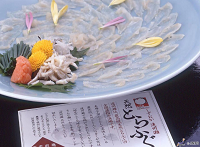Fugu
 Gail Umehara / Wordsmith
Gail Umehara / Wordsmith
During her 16 years in Japan, Gail juggled raising a family with, amongst other things, working as a translation assistant, librarian, and editor. Back in Australia, she continues to work with words as an interpreter, editor and TAFE lecturer.
Fugu
 In January this year, two people died after eating mushrooms they had found growing in Canberra. These were just cases of mistaken identity the deathcap mushroom, which grows wild in Canberra, looks very much like another mushroom often used in Asian cooking. In Japan, however, at least 23 fatalities have occurred since 2000 after people have eaten something they knew was poisonous: fugu, a fish whose English name, pufferfish or blowfish, reflects how it puffs itself up when under threat.
In January this year, two people died after eating mushrooms they had found growing in Canberra. These were just cases of mistaken identity the deathcap mushroom, which grows wild in Canberra, looks very much like another mushroom often used in Asian cooking. In Japan, however, at least 23 fatalities have occurred since 2000 after people have eaten something they knew was poisonous: fugu, a fish whose English name, pufferfish or blowfish, reflects how it puffs itself up when under threat.
Although the fish is not at all attractive ( 河豚 translates to "river pig"), the city of Shimonoseki uses a rather cute image of fugu on its manhole covers to remind everyone of the city's historic status as a major supplier of the fish that is famous for being both potentially deadly and a delicacy. Not all of the fish is poisonous if the organs are removed without releasing any of the highly toxic tetrodoxin they contain, the flesh is fine to eat. It is said, however, that part of the allure of eating fugu is the thrill of exposing yourself to danger. Of the 37 restaurants in Japan that have Michelin star rating, 14 are fugu restaurants!
After centuries of having deaths every year mostly because inexperienced people prepared the fish themselves; but sometimes because the chefs made a mistake, or customers demanded that their servings include a little of the poison to heighten their eating experience in 1958 the Tokyo Metropolitan Government brought in public health regulations, the strictest in the country, on preparing and serving fugu that required chefs to go through at least two years of training and to pass an extremely tough set of examinations. Although the pass rate is only 35%, there are hundreds of fugu-certified chefs throughout Japan. And a new development has them all concerned about the future of fugu restaurants.
From October this year, the rules will change in Tokyo. Instead of having to have a certified chef on the premises to serve fugu dishes, restaurants will only have to show that they have obtained their fugu from a licensed processor. One important factor in this decision is that researchers have discovered that it is possible to raise completely non-toxic fugu by controlling what the fugu eat.

